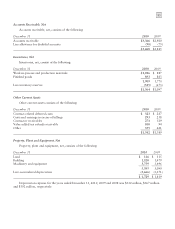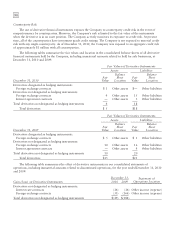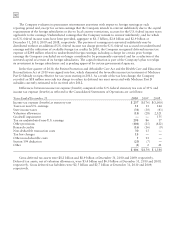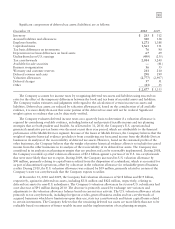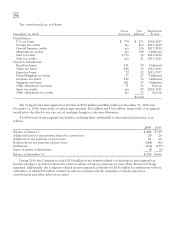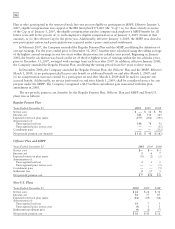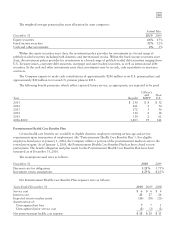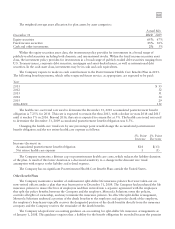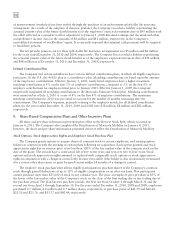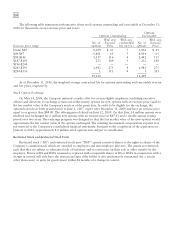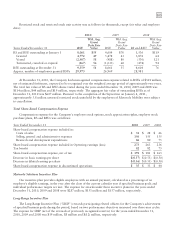Motorola 2010 Annual Report Download - page 103
Download and view the complete annual report
Please find page 103 of the 2010 Motorola annual report below. You can navigate through the pages in the report by either clicking on the pages listed below, or by using the keyword search tool below to find specific information within the annual report.
95
During 2010, the Internal Revenue Service concluded its audit of Symbol Technologies, Inc.’s 2004 through
January 9, 2007 pre-acquisition tax years and Motorola Solutions’ 2004 through 2007 tax years. The IRS is
currently examining the Company’s 2008 and 2009 tax years. The Company also has several state and non-U.S.
audits pending. A summary of open tax years by major jurisdiction is presented below:
Jurisdiction Tax Years
United States 2007—2010
Brazil 2005—2010
China 2001—2010
France 2004—2010
Germany 2008—2010
India 1996—2010
Israel 2007—2010
Japan 2004—2010
Malaysia 1998—2010
Singapore 1999—2010
United Kingdom 2004—2010
Although the final resolution of the Company’s global tax disputes is uncertain, based on current information,
in the opinion of the Company’s management, the ultimate disposition of these matters will not have a material
adverse effect on the Company’s consolidated financial position, liquidity or results of operations. However, an
unfavorable resolution of the Company’s global tax disputes could have a material adverse effect on the Company’s
consolidated financial position, liquidity or results of operations in the periods in which the matters are ultimately
resolved.
Based on the potential outcome of the Company’s global tax examinations, the expiration of the statute of
limitations for specific jurisdictions, or the continued ability to satisfy tax incentive obligations, it is reasonably
possible that the unrecognized tax benefits will change within the next 12 months. The associated net tax impact on
the effective tax rate, exclusive of valuation allowance changes, is estimated to be in the range of a $50 million tax
charge to a $75 million tax benefit, with cash payments in the range of $0 to $100 million.
At December 31, 2010, the Company had $25 million and $20 million accrued for interest and penalties,
respectively, on unrecognized tax benefits. At December 31, 2009, the Company had $25 million and $15 million
accrued for interest and penalties, respectively, on unrecognized tax benefits.
7. Retirement Benefits
Pension Benefit Plans
The Company’s noncontributory pension plan (the “Regular Pension Plan”) covers U.S. employees who became
eligible after one year of service. The benefit formula is dependent upon employee earnings and years of service.
Effective January 1, 2005, newly-hired employees were not eligible to participate in the Regular Pension Plan. The
Company also provides defined benefit plans which cover non-U.S. employees in certain jurisdictions, principally
the United Kingdom, Germany, Japan and Korea (the “Non-U.S. Plans”). Other pension plans are not material to
the Company either individually or in the aggregate.
The Company has a noncontributory supplemental retirement benefit plan (the “Officers’ Plan”) for its officers
elected prior to December 31, 1999. The Officers’ Plan contains provisions for vesting and funding the participants’
expected retirement benefits when the participants meet the minimum age and years of service requirements. Elected
officers who were not yet vested in the Officers’ Plan as of December 31, 1999 had the option to remain in the
Officers’ Plan or elect to have their benefit bought out in restricted stock units. Effective December 31, 1999, newly
elected officers are not eligible to participate in the Officers’ Plan. Effective June 30, 2005, salaries were frozen for
this plan.
The Company has an additional noncontributory supplemental retirement benefit plan, the Motorola
Supplemental Pension Plan (“MSPP”), which provides supplemental benefits to individuals by replacing the Regular
Pension Plan benefits that are lost by such individuals under the retirement formula due to application of the
limitations imposed by the Internal Revenue Code. However, elected officers who are covered under the Officers’


